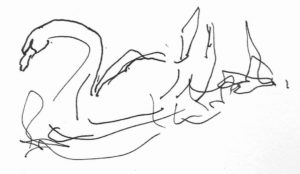Columnists
Nothing set in concrete

It’s just one of the things you know; an everyday object carries you down some not so everyday path.
It was over Sophiasburgh way that it happened, where a white swan’s neck called for attention above the straggle of a last year’s late summer yard sale. The neck didn’t belong to a real life bird but an interpretation, you know the ones that in some form or other seem to herd to many a garden and lawn to remain frozen for a season while you cut the grass around them.
Not being a lawn ornament type of person I nonetheless fell for the weathered look of this thing; thought I’d offer it new nesting grounds on the banks of Slab Creek. Turns out the bird is made of heavier-than-hell concrete. Reality hit while hoisting it into my truck—and no wonder the sellers wanted rid of it—but I reasoned that pound for pound I got an okay bargain.
Back in the 1950s objects made of concrete like my item was a poor man’s substitute for real-deal stone carvings. A mould would be made from an original design, the mould then fitted with a steel rod armature to add strength before being filled with cement. The set piece was then detailed with paint: the end result cheap to buy, everyone could have one and practically everyone did.
My swan now home, I enjoyed the patina that had fermented over years; I pondered its former travels. While the time had passed to plant vegetation in the cavity between its wings as it was designed to accommodate, the sleekness of design sufficed to entertain me well into autumn.
Come first snow I figured it had survived many winters outside and defaulting to the weight issue I chose to leave the swan in the garden. Like these things weren’t made exclusively for trailer parks in Florida I reasoned. But come this past March, to my chagrin, something more resembling a crumbling turkey vulture emerged from melting snow. Freeze and thaw cycles of Canadian winter had over-baked my bird.
As days grew warmer I studied anew my forlorn ornament just as the real swans began to return, the song of the air through powerful wings alive as they flew over my garden; then me standing on the old rail bridge at the Consecon Narrows witness to swan reflections echoed in quiet water; all of it brought back the Celtic lore that the magnificent bird symbolizes soul; regardless of physical appearance we all posses an inner radiance, the theme of the classic, ‘Swan and the Ugly Duckling’. My conviction to rehabilitate my garden icon was charged.
Sure there is the swan song, the lore of the dying bird; swan dive, the ‘impossible’ black swan, tundra swan, trumpeter swan, whooper swan, whistling swan, the mute swan, the Swan-Ganz catheter and also the swan neck flask used by Louis Pasteur in his experiments with bacteria. Then there was my forty-pound crumbling cement swan: But what to do?
I searched out tips for ‘how to’ repair and further indulged my curiosity into the history of garden adornment. While going back into Greek and Roman eras of outdoor statuary that graced the grounds of many, the culture caught on in North America especially after the housing boom of post WW2 when folks wanted to mark their territory within a sea of sameness of the subdivision.
Garden gnomes, peeing cherubs, bathtub Madonnas, lawn jockeys and wishing wells hit the billboards and became the “T-word” for tackiness as the tchotchkes were pumped out en masse made of plastic and resin. When art teacher Don Featherstone was commissioned by a local Massachusetts plastics manufacturer to come up with a form for a pink flamingo in 1957, photos from National Geographic were his inspiration. Then in the 1960s there was the racially sensitive issue around Jocko, the Black lawn jockey that had become a familiar statue everywhere. Turns out that Jocko was never a jockey as depicted, time had misaligned the truth. The icon had evolved from an original statue created to reside in the garden of George Washington. The figure honoured the person of Jocko Graves, a young volunteer in an African American regiment in Washington’s army. Graves faithfully guarded the horses as Washington led his troops across the Delaware River in winter to defeat British troops during the War of Independence. On their return Graves was found frozen to death holding the reigns of the General’s horse. Washington never forgot Graves’ loyalty.
The statues went on to play a vital part in the story of the Underground Railway. As escaping slaves followed the North Star to Canada, a green ribbon was tied to the arm of a Jocko statue as a signal that it was safe. A red ribbon signalled to keep moving. Not all owners of the properties that owned such a statue were aware of the messaging.
As I write this I move in and out of the house careful to wash my hands before returning to the keyboard. A solution to the rehabilitation of my swan was in my midst all along. Here in my studio lay rolls of gypsum cloth recently ordered for sculpting purposes. The cloth is familiar to anyone who has ever sat while a practitioner wrapped a fractured limb, unravelling the cloth and moistening it to activate the concretelike dust from which casts are made.
All writers will admit that forces within drive selfreveal. With gypsum now highlighting my keyboard I honour the fact that swan teachings have led me here, including going with the flow; paying attention to my feminine side of intuition, hunches and gut instinct and, importantly, accepting healing and transformation that is a constant presence in our lives. My concrete swan has announced itself as a teacher.
My hands have been guided to restore grace and dignity to its being. Songs and poetry which awaken the inner child are messages that have travelled through the centuries, all inspired by the grace and strength of the inner self that symbolizes Swan.
The work of wrapping my swan in a plaster cast is beautifully restoring its strength of natural beauty. When our mutual aid is completed it will have transformed into a garden tribute to the lessons of the swan.

Comments (0)